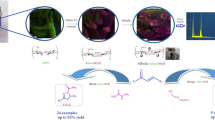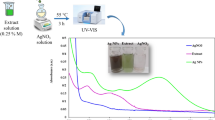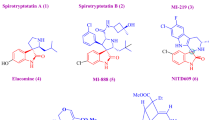Abstract
Extraction of diosgenin from the rhizome of Dioscorea by catalytic hydrolysis over recyclable solid acids is one of the most enviromentally friendly ways for the conversion of biomass into chemicals. In this paper, a magnetic solid acid, Fe3O4@SiO2@NH-(CH2)2-NH2@SO3H with the particle size of about 80 nm, was synthesized by using Fe3O4 (~ 20 nm) as a magnetic core and then coated orderly with tetraethyl orthosilicate (TEOS) and N-{3-(Trimethoxysilyl) propyl} ethylenediamine (TMPED) by sol-gel reactions in water/ethanol solution, followed by the sulfonation of chlorosulfonic acid. The solid acid was characterized by Fourier transform infrared spectroscopy (FTIR), thermogravimetric analysis (TGA), scanning electron microscope (SEM), X-ray diffraction (XRD), vibrating sample magnetometer (VSM), and X-ray photoelectron spectroscopy (XPS). The content of acidic sites on the surface of the solid acid was 1.01 mmol/g, measured by back titration method. The prepared solid acid was used to hydrolyze and extract diosgenin from Dioscorea nipponica Makino (DNM). The results show that the magnetic solid acid has higher hydrolysis activity than 2.5 M hydrochloric acid under same hydrolysis conditions, at 110 °C for 5 h. In addition, the magnetic solid acid can be easily separated from the reaction mixture by the application of a magnet and reused several times without significant activity loss. This work has a potential application value for the extraction of diosgenin from plants.









Similar content being viewed by others
References
Afradi M, Foroughifar N, Pasdar H, Moghanian H (2016) L-proline N-sulfonic acid-functionalized magnetic nanoparticles: a novel and magnetically reusable catalyst for one-pot synthesis of 3,4-dihydropyrimidine-2-(1H)-thiones under solvent-free conditions. RSC Adv 6:59343–59351
Alemi-Tameh F, Safaei-Ghomi J, Mahmoudi-Hashemi M, Teymuri R (2016) A comparative study on the catalytic activity of Fe3O4@SiO2–SO3H and Fe3O4@SiO2–NH2 nanoparticles for the synthesis of spiro [chromeno [2, 3-c] pyrazole-4, 3′-indoline]-diones under mild conditions. Res Chem Intermediat 42:6391–6406
Che YL, Xu Y, Wang RJ, Chen L (2017) Rapid fluorescence detection of pathogenic bacteria using magnetic enrichment technique combined with magnetophoretic chromatography. Anal Bioanal Chem 409:4709–4718
Deng YH, Cai Y, Sun ZK, Liu J, Liu C, Wei J, Li W, Liu C, Wang Y, Zhao DY (2010) Multifunctional mesoporous composite microspheres with well-designed nanostructure: a highly integrated catalyst system. J Am Chem Soc 132:8466–8473
Elhamifar D, Ramazani Z, Norouzi M, Mirbagheri R (2018) Magnetic iron oxide/phenylsulfonic acid: a novel, efficient and recoverable nanocatalyst for green synthesis of tetrahydrobenzo[b]pyrans under ultrasonic conditions. J Colloid Interf Sci 511:392–401
Elsayed I, Mashaly M, Eltaweel F, Jackson MA, Hassan EB (2018) Dehydration of glucose to 5-hydroxymethylfurfural by a core-shell Fe3O4@SiO2-SO3H magnetic nanoparticle catalyst. Fuel 221:407–416
Fan Z, Zhou L, Xiong TQ, Zhou JS, Li QG, Tan QL, Zhao ZX, Jin J (2015) Antiplatelet aggregation triterpene saponins from the barks of Ilex rotunda. Fitoterapia 101:19–26
Gill CS, Price BA, Jones CW (2007) Sulfonic acid-functionalized silica-coated magnetic nanoparticle catalysts. J Catal 251:145–152
Hu L, Li Z, Wu Z, Lin L, Zhou SY (2016) Catalytic hydrolysis of microcrystalline and rice straw-derived cellulose over a chlorine-doped magnetic carbonaceous solid acid. Ind Crop Prod 84:408–417
Karami K, Najvani SD, Naeini NH, Hervés P (2015) Palladium particles from oxime-derived palladacycle supported on Fe3O4/oleic acid as a catalyst for the copper-free Sonogashira cross-coupling reaction. Chinese J Catal 36:1047–1053
Khorshidi A, Shariati S (2015) Efficient synthesis of 3,3′-bisindoles catalyzed by Fe3O4@MCM-48-OSO3H magnetic core-shell nanoparticles. Chinese J Catal 36:778–784
Koukabi N, Kolvari E, Zolfigol MA, Khazaei A, Shaghasemi BS, Fasahati B (2012) A magnetic particle-supported sulfonic acid catalyst: tuning catalytic activity between homogeneous and heterogeneous catalysis. Adv Synth Catal 354:2001–2008
Lai DM, Deng L, Guo QX, Fu Y (2011a) Hydrolysis of biomass by magnetic solid acid. Energy Environ Sci 4:3552–3557
Lai DM, Deng L, Li J, Liao B, Guo QX, Fu Y (2011b) Hydrolysis of cellulose into glucose by magnetic solid acid. ChemSusChem 4:55–58
Lei L, Zhang W, Gao ZC, Liu L, Yu XD (2018) Preparation of diosgenin from Dioscorea zingiberensis C. H. Wright by stepwise biocatalysis-foam separation-preparative high-performance liquid chromatography (P-HPLC) European Food Research and Technology 244:1447–1452
Le X, Dong ZP, Liu YS, Jin ZC, Huy TD, Le M, Ma JT (2014) Palladium nanoparticles immobilized on core–shell magnetic fibers as a highly efficient and recyclable heterogeneous catalyst for the reduction of 4-nitrophenol and Suzuki coupling reactions. J Mater Chem A 2:19696–19706
Li JQ, Liang XZ (2017) Magnetic solid acid catalyst for biodiesel synthesis from waste oil. Energ Convers Manag 141:126–132
Li PQ, Mou Y, Lu SQ, Sun WB, Lou JF, Yin CH, Zhou LG (2012) Quantitative determination of diosgenin in Dioscorea zingiberensis cell cultures by microplate-spectrophotometry and high-performance liquid chromatography. Afr J Pharm Pharmaco 6:1186–1193
Maleki A, Hajizadeh Z, Firouzi-Haji R (2018) Eco-friendly functionalization of magnetic halloysite nanotube with SO3H for synthesis of dihydropyrimidinones. Micropor Mesopor Mat 259:46–53
Man SL, Gao WY, Zhang YJ, Huang LQ, Liu CX (2010) Chemical study and medical application of saponins as anti-cancer agents. Fitoterapia 81:703–714
Mirfakhraei S, Hekmati M, Eshbala FH, Veisi H (2018) Fe3O4/PEG-SO3H as a heterogeneous and magnetically-recyclable nanocatalyst for the oxidation of sulfides to sulfones or sulfoxides. New J Chem 42:1757–1761
Mirhosseyni MS, Nemati F, Elhampour A (2016) Hollow Fe3O4@DA-SO3H: an efficient and reusable heterogeneous nano-magnetic acid catalyst for synthesis of dihydropyridine and dioxodecahydroacridine derivatives. J Iran Chem Soc 14:791–801
Mohammadi R, Kassaee MZ (2013) Sulfochitosan encapsulated nano-Fe3O4 as an efficient and reusable magnetic catalyst for green synthesis of 2-amino-4H-chromen-4-yl phosphonates. J Mol Catal A Chem 380:152–158
Moses T, Papadopoulou KK, Osbourn A (2014) Metabolic and functional diversity of saponins, biosynthetic intermediates and semi-synthetic derivatives. Crit Rev Biochem Mol Biol 49:439–462
Mukherjee S, Sarkar S, Pramanik A (2018) A sustainable synthesis of functionalized pyrrole fused coumarins under solvent-free conditions using magnetic nanocatalyst and a new route to Polyaromatic Indolocoumarins. ChemistrySelect 3:1537–1544
Nasr-Esfahani M, Rafiee Z, Montazerozohori M, Kashi H (2016) A highly efficient magnetic solid acid nanocatalyst for the synthesis of new bulky heterocyclic compounds. RSC Adv 6:47298–47313
Pang X, Huang HZ, Zhao Y, Xiong CQ, Yu LY, Ma BP (2015) Conversion of furostanol saponins into spirostanol saponins improves the yield of diosgenin from Dioscorea zingiberensis by acid hydrolysis. RSC Adv 5:4831–4837
Peng YE, Yang ZH, Wang YX, Liu ZY, Bao JG, Hong Y (2011) Pathways for the steroidal saponins conversion to diosgenin during acid hydrolysis of Dioscorea zingiberensis C. H Wright Chem Eng Res Des 89:2620–2625
Rajkumari K, Kalita J, Das D, Rokhum L (2017) Magnetic Fe3O4@silica sulfuric acid nanoparticles promoted regioselective protection/deprotection of alcohols with dihydropyran under solvent-free conditions. RSC Adv 7:56559–56565
Rothrock JW, Stoudt TH, Garber JD (1955) Isolation of diosgenin by microbiological hydrolysis of saponin. Arch Biochem Biophys 57:151–155
Shang MY, Wang WQ, Zou HZ, Ren GH (2016) Coating Fe3O4 spheres with polypyrrole-Pd composites and their application as recyclable catalysts. Synthetic Met 221:142–148
Shao JG, Xie XC, Xi YJ, Liu XN, Yang YX (2013) Characterization of Fe3O4/SiO2 composite core-shell nanoparticles synthesized in isopropanol medium. Glas Phys Chem 39:329–335
Shariati S, Faraji M, Yamini Y, Rajabi AA (2011) Fe3O4 magnetic nanoparticles modified with sodium dodecyl sulfate for removal of safranin O dye from aqueous solutions. Desalination 270:160–165
Sun LJ, He J, An SS, Zhang JW, Zheng JM, Ren D (2013) Recyclable Fe3O4@SiO2-Ag magnetic nanospheres for the rapid decolorizing of dye pollutants. Chinese J Catal 34:1378–1385
Taheri S, Veisi H, Hekmati M (2017) Application of polydopamine sulfamic acid-functionalized magnetic Fe3O4 nanoparticles (Fe3O4@PDA-SO3H) as a heterogeneous and recyclable nanocatalyst for the formylation of alcohols and amines under solvent-free conditions. New J Chem 41:5075–5081
Tava A, Biazzi E, Mella M, Quadrelli P, Avato P (2017) Artefact formation during acid hydrolysis of saponins from Medicago spp. Phytochemistry 138:116–127
Thombal RS, Jadhav VH (2016a) Application of glucose derived magnetic solid acid for etherification of 5-HMF to 5-EMF, dehydration of sorbitol to isosorbide, and esterification of fatty acids. Tetrahedron Lett 57:4398–4400
Thombal RS, Jadhav VH (2016b) Facile O-glycosylation of glycals using Glu-Fe3O4-SO3H, a magnetic solid acid catalyst. RSC Adv 6:30846–30851
Wang JR, Yau LF, Gao WN, Liu Y, Yick PW, Liu L, Jiang ZH (2014b) Quantitative comparison and metabolite profiling of saponins in different parts of the root of Panax notoginseng. J Agric Food Chem 62:9024–9034
Wang J, Yang KD, Chen J (2004) Determination of Diosgenin by spectrophotometry. Chinese J Anal Lab 23:73–75
Wang P, Ma CY, Chen SW, Zhu S, Lou ZX, Wang HX (2014) Conversion of steroid saponins into diosgenin by catalytic hydrolysis using acid-functionalized ionic liquid under microwave irradiation. J Clean Prod 79:265–270
Wang YQ, Zou BF, Gao T, Wu XP, Lou SY, Zhou SM (2012) Synthesis of orange-like Fe3O4/PPy composite microspheres and their excellent Cr(vi) ion removal properties. J Mater Chem 22:9034–9040
Xiong Y, Zhang ZH, Wang X, Liu B, Lin JT (2014) Hydrolysis of cellulose in ionic liquids catalyzed by a magnetically-recoverable solid acid catalyst. Chem Eng J 235:349–355
Yang H, Yin HW, Shen YP, Xia GH, Zhang B, Wu XY, Cai BC, Tam JP (2016) A more ecological and efficient approach for producing diosgenin from Dioscorea zingiberensis tubers via pressurized biphase acid hydrolysis. J Clean Prod 131:10–19
Yan W, Ji L, Hang S, Shun Y (2013) New ionic liquid-based preparative method for diosgenin from Rhizoma dioscoreae nipponicae. Pharmacogn Mag 9:250–254
Yu CJ, Li ZH, Yin HW, Xia GH, Shen YP, Yang H, Jing G, Jia XB (2019) Green production of diosgenin from Discorea nipponica Makino tubers based on pressurized biphase acid hydrolysis via response surface methodology optimization. Green Chem Lett Rev 12:79–88
Zhang CB, Wang HY, Liu FD, Wang L, He H (2013) Magnetic core–shell Fe3O4@C-SO3H nanoparticle catalyst for hydrolysis of cellulose. Cellulose 20:127–134
Zhou JJ, Li YN, Sun HB, Tang ZK, Qi L, Liu L, Ai YJ, Li S, Shao ZX, Liang QL (2017) Porous silica-encapsulated and magnetically recoverable Rh NPs: a highly efficient, stable and green catalyst for catalytic transfer hydrogenation with “slow-release” of stoichiometric hydrazine in water. Green Chem 19:1–7
Funding
This work was financially supported by Hubei provincial science and technology department (2018ACA158) and the tenth postgraduate education innovation fund of Wuhan Institute of Technology, China (CX2018156).
Author information
Authors and Affiliations
Corresponding author
Ethics declarations
Conflict of interest
The authors declare that they have no conflict of interest.
Additional information
Publisher’s note
Springer Nature remains neutral with regard to jurisdictional claims in published maps and institutional affiliations.
Electronic supplementary material
ESM 1
(DOCX 953 kb)
Rights and permissions
About this article
Cite this article
Zhang, F., Shen, B., Jiang, W. et al. Hydrolysis extraction of diosgenin from Dioscorea nipponica Makino by sulfonated magnetic solid composites. J Nanopart Res 21, 269 (2019). https://doi.org/10.1007/s11051-019-4702-3
Received:
Accepted:
Published:
DOI: https://doi.org/10.1007/s11051-019-4702-3




